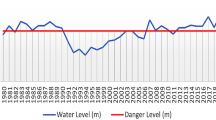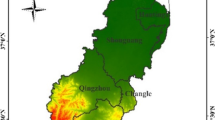Abstract
This paper combines a risk-based two-stage stochastic robust programming (RTSRP) model into an agricultural-ecological system dynamics (AESD) to conduct agricultural-ecological water resources management. It integrates the chance- constrained programming, conditional risk-at-value, two-stage stochastic robust programming with the AESD model. The RTSRP model improves upon the TSRP model by introducing the risk control measurements. The agricultural-ecological dynamic system (AEDS) model can build water connections amid wheat, field corn, seed corn, economic crops, woodland, meadow, and city greening and farmland shelterbelts. Besides, the ecological service value is transformed into the irrigation benefit of ecological sector to guide water allocation amid sub-ecological sectors at a more applicable detailed scale. It can tradeoff relationships between economic benefit and ecological recovery by formulating two enlarging ecological areas scenarios. The combinations of the RTSRP model and the AEDS model can get optimal water allocation schemes, and simulate future sustainable degree (SD) of optimal water allocation schemes and explore relationships amid water allocation, economic benefit, and SD and risk and robustness of model. It is used to the middle reaches of the Heihe River Basin in China to verify its application. The results show that water allocation schemes have different responses on various risk scenarios. Higher water allocation corresponds to bigger water shortage risk and higher robustness of the model. The economic benefit positive with water allocation is contradictory with SD. Enlarging ecological areas contributes to improvements of economic benefit and ecological recovery, but not the SD under the condition of enough water resources.











Similar content being viewed by others
Availability of data
The data can be obtained after asking for the corresponding author.
References
Bao C, Zhou JJ (2018) Analysis of spatiotemporal changes of the human-water relationship using water resources constraint intensity index in Northwest China. Ecol Indic 84:119–129
Cai YP, Yue WC, Xu LY et al (2016) Sustainable urban water resources management considering life-cycle environmental impacts of water utilization under uncertainty. Resourc Conserv Recycl 108:21–40
Che YJ, Jiang MX, Zhong YC (2018) The study on temporal and spatial variation of ecological service value in Poyang lake ecological economic zone based on the variation of land utilization. J Jiangxi Normal Univ 42:45–51
Fu Q, Li LQ, Li M, Li TX (2018a) An interval parameter conditional value-at-risk two-stage stochastic programming model for sustainable regional water allocation under different representative concentration pathways scenarios. J Hydrol 564:115–1124
Fu Q, Li TX, Cui S, Liu D, Lu XP (2018b) Agricultural multi-water source allocation model based on interval two-stage stochastic robust programming under uncertainty. Water Resour Manag 32:1261–1274
Hu ZN, Wei CT, Yao LM et al (2016) A multi-objective optimization model with conditional value-at-risk constraints for water allocation equality. J Hydrol 542:330–342
El-Gafy KI (2014) System dynamic model for crop production, water footprint, and virtual water nexus. Water Resour Manag 28:4467–4490
Li M, Guo P, Ren CF (2015a) Water resources management models based on two-level linear fractional programming method under uncertainty. J Water Resourc Plan Manag 14(9):5915001
Li R, Guo P, Li J (2018) Regional water use structure optimization under multiple uncertainties based on water resources vulnerability analysis. Water Resour Manag 32:1827–1847
Li W, Wang B, Xie YL et al (2015b) An inexact mixed risk-aversion two-stage stochastic programming model for water resources management under uncertainty. Environ Sci Pollut Res 22:2964–2975
Li XN, Wang XS, Guo HY, Ma WM (2020) Multi-water resources optimal allocation based on multi-objective uncertain chance-constrained programming model. Water Resour Manag 34:4881–4899
Li Z, Huang GH, Zhang Y et al (2013) Inexact two-stage stochastic credibility constrained programming for water quality management. Resourc Conserv Recycl 73:122–132
Liu X, Ma SF, Tian JF et al (2015) A system dynamics approach to scenario analysis for urban passenger transport energy consumption and CO2 emissions: A case study of Beijing. Energy Policy 85:253–270
Madadi MR, Akbarifard S, Qaderi K (2020) Performance evaluation of improved symbiotic organism search algorithm for estimation of solute transport in rivers. Water Resources Manag 1:1–12
Jiang CH, Li GY, Li HQ, Li M (2017) The study of ecological service value of farmland ecosystem in the Beijing-Tianjin-Hebei region. Earth Environ Sci
Perrone A, Inam A, Albano R et al (2020) A participatory system dynamics modeling approach to facilitate collaborative flood risk management: a case study in the Bradano River (Italy). J Hydrol 580:124354
Raso L, Malaterre PO, Bader JC (2017) Effective streamflow process modeling for optimal reservoir operation using stochastic dual dynamic programming. J Water Resourc Plan Manag 143:1
Ren CF, Guo P, Li M et al (2013) Optimization of industrial structure considering the uncertainty of water resources. Water Resources Manag 27:3885–3898
Shao LG, Qin XS, Xu Y (2011) A conditional value-at-risk based inexact water allocation model. Water Resourc Manag 25:2125–2145
Sutton PC, Anderson S, Constanza R, Kubiszewski L (2016) The ecological economics of land degradation: Impacts on ecosystem service values. Ecol Econ 129:1
Wang YZ, Li Z, Guo SS et al (2020) A risk-based fuzzy boundary interval two-stage stochastic water resources management programming approach under uncertainty. J Hydrol 582:124553
Zhang CL, Ping G (2018) An inexact CVaR two-stage mixed-integer linear programming approach for agricultural water management under uncertainty considering ecological water requirement. Ecol Indic 92:342–353
Zhang K, Li YP, Huang GH et al (2016) Planning regional ecosystem sustainability under multiple uncertainties—an interval stochastic credibility-constrained programming approach. Ecol Indicat 70:134–150
Acknowledgements
This study was financially supported by the National Natural Science Foundation of China (No. 41871199), and supported by the New Mexico Water Resources Research Institute at New Mexico State University and thanks for the help of Yining Bai at New Mexico Water Resources Research Institute at New Mexico State University.
Author information
Authors and Affiliations
Corresponding author
Ethics declarations
Conflicts of interest
We declare that we have no financial and personal relationships with other people or organizations that can inappropriately influence our work. There is no professional or other personal interest of any nature or kind in any product, service and/or company that could be construed as influencing the position presented in, or the review of, the manuscript entitled.
Additional information
Publisher's Note
Springer Nature remains neutral with regard to jurisdictional claims in published maps and institutional affiliations.
Rights and permissions
About this article
Cite this article
Youzhi, W., Alexander, F. & Ping, G. A model integrating the system dynamic model with the risk based two-stage stochastic robust programming model for agricultural-ecological water resources management. Stoch Environ Res Risk Assess 35, 1953–1968 (2021). https://doi.org/10.1007/s00477-021-01972-8
Accepted:
Published:
Issue Date:
DOI: https://doi.org/10.1007/s00477-021-01972-8




